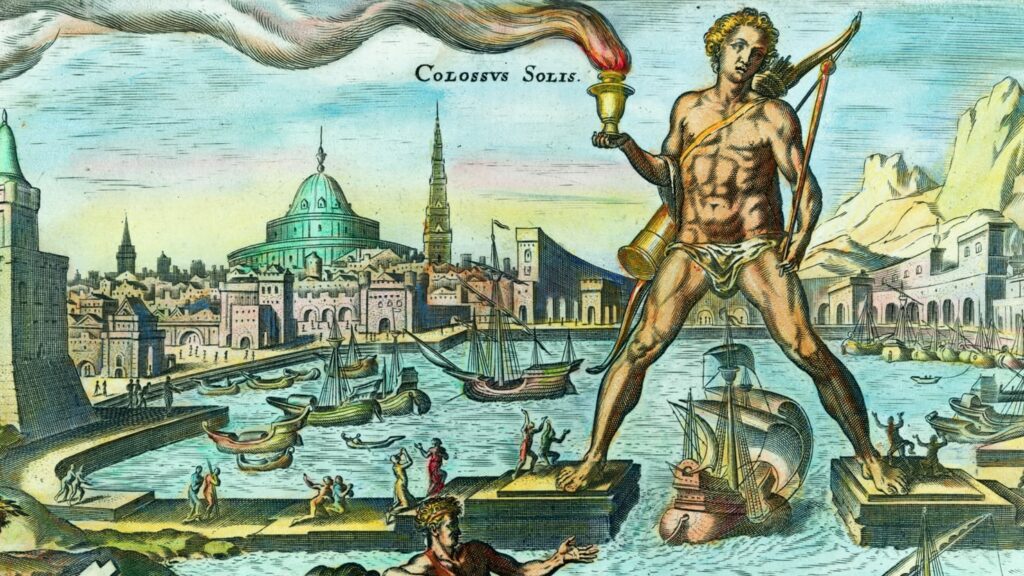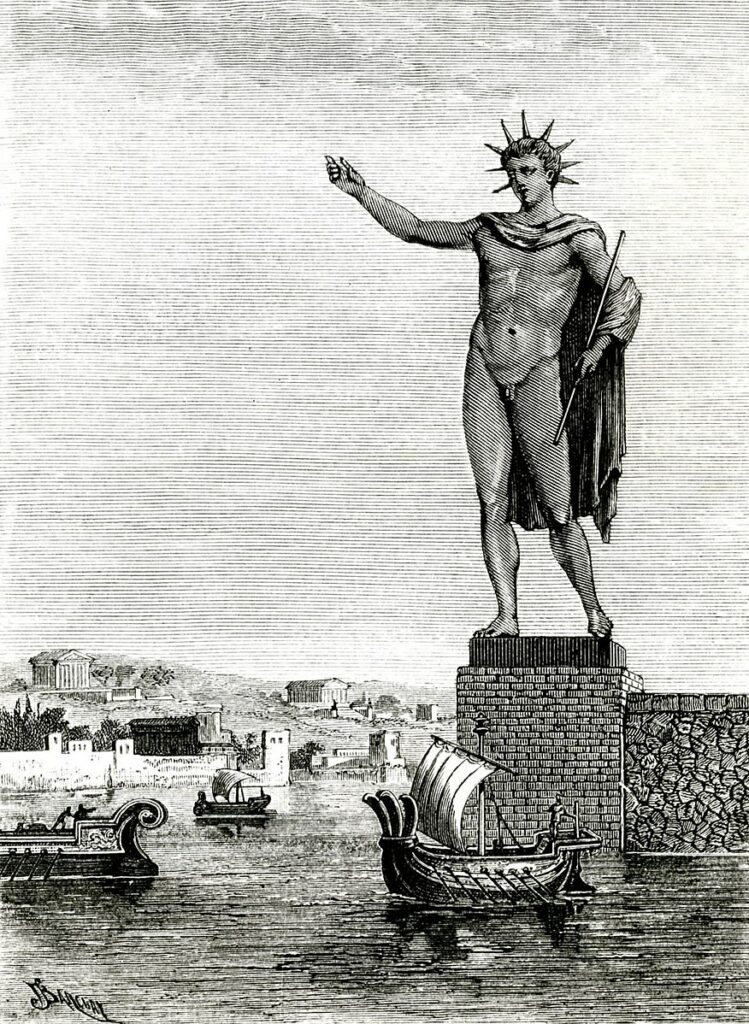The 108-foot bronze statue known as the Colossus of Rhodes was both an ancient wonder and a proud monument. It was a tribute to the god Helios. It was destroyed in an earthquake just five decades after it was built.
To see it standing over the harbors of Rhodes as ships sailed beneath it would have been a truly extraordinary sight. Like many of the other ancient wonders of the world, we may not be able to see it today, but that doesn’t stop some people from wanting to bring this magnificent statue back to life.
Let’s take a look at the history of the Colossus of Rhodes and what makes this statue so special.

Origins of the Colossus of Rhodes
The city of Rhodes was located on the Greek island of the same name. This island was part of a chain of ten islands known as the Dodecanese island group.
As the largest of these islands, Rhodes played an important role in the ancient maritime world. It was positioned between Greece and the Levant. This allowed it to become a significant commercial power.
Unfortunately, Rhodes’ geographic position also made it a target when it got on the wrong side of its neighbors.
Before the fourth century BC, Rhodes was part of the Athenian confederation known as the Delian League. This was a coalition of Greek states that came together to stand up to the dual threats of Sparta and Persia.
By the mid-fourth century BC, however, the strands binding the members of the alliance began to fray. Rhodes took the side of Persia in a conflict with Alexander the Great.
Sensing that Alexander would be the victor in that conflict, Rhodes eventually switched sides, finishing the war on the side of the Greeks. After Alexander died in 323 BC, Rhodes continued to support the Egyptian general Ptolemy, who was Alexander’s ally, rather than the King of Macedonia, Antigonus I.
This diplomatic back-and-forth eventually led to the events that would give rise to the Colossus of Rhodes.
Antigonus I was determined to get Rhodes on his side. And if not, he preferred to destroy the city rather than let them continue supporting his enemy. So, when Rhodes refused to join him, Antigonus I sent his son, Demetrius to lay siege to the city.
This should have been an easy victory for the Macedonians. Demetrius and his men had the latest weaponry and even brought with them a siege engine.
But the Rhodians held out valiantly for nearly a year, at which point Antigonus allied with them while allowing Rhodes to continue trading with Egypt. Rhodes, it seems, had gotten exactly what it had wanted.
But there was more. When Demetrius pulled out of Rhodes with his army, they left behind much of their war equipment, including the siege engine that had proved so ineffective.
The Rhodians decided to sell off the abandoned equipment and use the proceeds to build a great monument to their favorite god: Helios.

Building the Colossus of Rhodes
The people of Rhodes, flush with joy after their victory over the Macedonians, chose a local sculptor named Chares of Lindos to build the statue.
Chares already built several statues of Alexander the Great during his career, but never anything so large as the Colossus. In fact, at a towering 33m tall, the statue gave a new meaning to the word “colossus.”
Before the Colossus of Rhodes, the word “colossus” was used for statues both large and small. Afterward, that descriptor became associated only with truly grand statues.
Various ancient authors tried to describe the Colossus of Rhodes, but all of their descriptions are based on earlier writings since the statue only stood for 54 years.
According to them, the Colossus was cast in a bronze exterior with an iron core. Due to its rather flimsy design, the statue was weighted down with rocks for good measure.
The Rhodians hoped that these measures would be enough to stabilize the statue and keep it standing for centuries to come.
The Final Days of the Colossus
None of these precautions were enough to save the statue from toppling in an earthquake that came in either 227 or 224 BC.
According to the ancient philosopher Strabo, the earthquake caused the giant statue to break off at the knees and tumble onto the ground.
Ptolemy the III, then the pharaoh of Egypt, offered to pay for the rebuilding of the Colossus, but the Oracle of Delphi instructed the Rhodians to never attempt to restore the statue since Helios was displeased with it.
Thus, the once proud statue was left in ruins on the ground.
Even though it was never rebuilt, the ruins of the great Colossus of Rhodes remained a tourist attraction for centuries. Pliny the Elder, who visited the fallen statue, remarked, “But even lying on the ground, it is a marvel.”
It remained that way for several centuries until 645 AD when it finally met its ultimate end.
That was the year that a Muslim army, led by Caliph Muawiyah I, invaded Rhodes and decided they had little use for the statue other than its valuable bronze exterior. They scrapped what remained of the fallen statue and sold its parts to a Jewish merchant.
According to legend, the fragments of the once great Colossus were so numerous they had to be carried away on the backs of over 900 camels.
Modern Attempts to Rebuild the Colossus of Rhodes
In the 21st century, architects and officials on Rhodes decided to ignore the Oracle’s warning. They made several attempts to rebuild the statue.
In 1999, on the eve of the new millennium, there was a concerted effort to rebuild the statue using the projected design of the original as the model for the new statue.
They planned to make the new Colossus a “monument for the new millennium.” They wanted to dedicate it to, “international peace and cooperation at a historic crossroads between Europe, Asia, and the Middle East.”
Despite their hopes of having it completed by the time of the 2004 Olympic Games in Athens, that project never came to fruition.
The most recent attempt to rebuild the Colossus of Rhodes came in 2015, with a vision that was quite distinct from the original.
Rather than simply rebuild the ancient 100-foot statue according to its original design, this new team of European architects wanted to make it 500 feet tall. They wanted it to be a tourist attraction, and also a community space that would help bolster the flagging Greek economy.
This $283 million project was supposed to be an investment that would help “ease the economic hardships that have plagued Greece.” The planned statue would have a library, a cultural center, an exhibition hall, and a lighthouse. It would also employ local workers during the contraction, which would provide much-needed employment.
Like so many other attempts to reconstruct this ancient wonder, these plans never led to any real work being done. Perhaps it’s just too complicated and too costly a project to pull off. Or perhaps Rhodes never regained the favor of its favorite god, Helios.
Whatever the case, only time will tell whether Rhodes will ever again see the Colossus that once towered over its bustling harbor.

